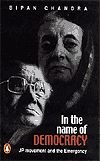|
|
| |
BOOK
REVIEW
Indian
democracy imperiled
In the Name of Democracy, by Bipan
Chandra
Reviewed by Sreeram Chaulia
 The
years 1974-1977 were Indian democracy's most
testing and turbulent times. Hacks had been
sharpening their knives to prove the
unsuitability of liberal democracy to an
underdeveloped and impoverished India, using
the "bread versus freedom" analogy
of Singaporean strongman Lee Kuan Yew. They
felt vindicated in the wake of Jayaprakash
Narayan's extra-constitutional struggle (JP
Movement) to dislodge prime minister Indira
Gandhi and the latter's decision to suspend
political and economic rights through a state
of internal emergency. Of course, the epitaph
writers were wrong and India's democratic
"political miracle" (W H
Morris-Jones) continues to this day. The
years 1974-1977 were Indian democracy's most
testing and turbulent times. Hacks had been
sharpening their knives to prove the
unsuitability of liberal democracy to an
underdeveloped and impoverished India, using
the "bread versus freedom" analogy
of Singaporean strongman Lee Kuan Yew. They
felt vindicated in the wake of Jayaprakash
Narayan's extra-constitutional struggle (JP
Movement) to dislodge prime minister Indira
Gandhi and the latter's decision to suspend
political and economic rights through a state
of internal emergency. Of course, the epitaph
writers were wrong and India's democratic
"political miracle" (W H
Morris-Jones) continues to this day.
However, there is no doubt that the JP
Movement and emergency gave Indian democracy a
close shave without cutting the skin. Veteran
historian Bipan Chandra's new book sheds light
on the totalitarian-fascist potential in these
two watershed developments that could have
overturned consensual form of government for
good. "Not all popular mass movements
lead to or strengthen democracy ... [and]
regimes which claimed to be defending
democracy have themselves ended up as
dictatorships." (p 3)
During 1972-1974, deep economic recession,
unemployment and inflation created a
groundswell of discontent, agitation and anger
all over India, laying the socio-economic
carpet for upheaval. The Congress party had
been declining as an organization and was
unprepared to deal with the snowballing
crisis. Growing corruption in large areas of
public life and belief that higher echelons of
the ruling party and administration were
responsible for the rot gained ground. Indira
Gandhi's refusal to acknowledge corruption as
a serious socio-political malady compounded
matters and eroded her phenomenal standing and
charisma.
If the urban middle classes were upset about
rising costs of living, rich peasants were
getting alienated from the Congress rapidly,
no longer seeing it as an effective instrument
for serving their group interests. Big
business houses went on an "investment
strike" to protest Gandhi's radical
leftism, thereby exacerbating the economic
downturn. Opposition parties' desperation and
reliance on massive extra-legal agitational
politics to remove elected ministries and
dissolve tenured legislatures also contributed
to the atmosphere of turmoil.
Trouble broke out first in Gujarat in early
1974, with large-scale rioting and the burning
and looting of shops. For more than 10 weeks,
the state was in a condition of near anarchy.
Though urban workers and rural landless poor
kept out of the fracas, disaffected urban
middle classes and students managed to bring
government functioning to a standstill. From
Gujarat, the tensions spread to Bihar, where
the city of Patna was "under almost
complete control of the mobs" and the
state itself "gave the appearance of a
vast armed camp". (p 40) Jayaprakash
Narayan suddenly emerged from reclusive
Gandhian social work to take charge of the
anti-government rallies in Bihar. Believing
that the youth were historical agents of
social change, J P announced that the moment
for "total revolution" had come.
J P's holistic agenda for revolution included
all-round changes to the pattern of education,
elimination of corruption, checking moral
decline in politics, basic electoral reforms,
building up "people's power" and
"saving democracy from authoritarian
trends". Most of these grandiose
objectives remained non-starters and J P soon
narrowed down the focus of the movement to the
removal of Indira Gandhi from office, even
though general elections were not due until
1976. The prime minister believed that having
secured political power via democratic and
constitutional means in the 1971 elections,
she had every right to continue ruling. Eyeing
the opportunity of piggybacking on J P's moral
image, opposition parties joined the chorus
for Gandhi's ouster without waiting for the
people's verdict in 1976. Lacking the strong
mass base and mobilizing cadre of workers that
parties like Jan Sangh, Congress (O),
Bharatiya Lok Dal and Akali Dal could muster,
J P also accepted this marriage of
convenience.
Despite the strategic alliances, the J P
Movement ran out of steam by early 1975.
"Students had lost their enthusiasm ...
their luster and credibility in the public eye
had also begun to fade." (p 54) Indira
Gandhi sensed the opportunity and openly
challenged J P to fight her in the
constitutional arena, ie the elections of
1976. With the movement at an impasse, J P
accepted the gauntlet thrown at him and
started organizing for an electoral battle.
Just as unrest and agitation were being
directed into the conventional channels of the
system, the Allahabad High Court delivered in
June 1975 a super-controversial verdict that
Gandhi's 1971 election victory as an MP was
invalid due to two minor technical offenses
under electoral law.
The movement's strategy took a markedly
radical turn as opposition allies converted J
P to the coup d'etat school of thought and
went on the rampage, demanding immediate
resignation of the prime minister. Gandhi's
popularity among the rural poor and urban
workers was undisturbed by the pandemonium of
the last two years and her chances of getting
re-elected in 1976 were still bright. Morarji
Desai, the opposition leader, saw the
Allahabad court decision as a shortcut to
power and said, "One must strike the iron
when it is hot ... it's increasingly difficult
to defeat her in a general election." (p
88) A gigantic civil disobedience campaign was
unleashed by J P, calling not only the people
but also the armed forces, police and
government servants to disobey orders from a
"dictatorial and fascist" regime.
The culmination of the remove Indira roar was
J P's plan to gherao (encircle) the
premier's residence in Delhi with hundreds of
thousands of his supporters who would permit
none to enter or leave the house. Gandhi
viewed the last threat as taken straight out
of Mussolini's march on Rome, a serious danger
to democracy that would require the army's
intervention to disperse the surging crowds.
In fact, "One reason she imposed the
emergency was because she did not want to rely
on the army for dealing with the civil
disobedience movement." (p 80) On June
26, 1975, in a lightning response, internal
emergency was proclaimed under article 352 of
the Indian constitution. J P and a slew of
opposition leaders were arrested, strict press
censorship imposed and all fundamental rights
suspended. Defending the emergency as
indispensable for state survival, Gandhi
argued, "Some rights have to suffer a
little if it is in the cause of strengthening
and survival of our country." (p 79)
So furious was the government onslaught and so
feeble the resistance to the emergency from
civil society that the backbone of the
movement was broken in a few months and J P
was left ruing that his "world lay in
shambles". Chandra highlights the
weaknesses inherent in J P as a mass leader
that led to the demise of his total
revolution. J P was "unable either to
diagnose the ills of the Indian polity or
suggest effective remedies for them" and
merely heaped all the blame on Congress and
Indira Gandhi. Chandra employs adjectives such
as naivete, confusion, woolly thinking, hazy,
unrealistic, romantic, rhetorical, generality,
Utopian, inchoate, commonplace, abstract,
exaggeration, hyperbole, inconsistent,
anomalous, arbitrary, opportunistic, nebulous
etc for J P's schemes. Needless to add, the
movement was "undemocratic" and
"unconstitutional" in its
composition, aims and methods. Having a social
base in right-wing forces, it was
"capable of creating a space for those of
its constituents that were authoritarian or
fascist". (p 154)
The monster that the JP Movement failed to
uncork was more than compensated by the
emergency. As many as 110,000 persons were
arbitrarily detained for the 19 months of
Gandhi's undemocratic governance. "People
were arrested on the slightest suspicion or on
the basis of rumors." (p 157) Parliament
was emasculated to rubber-stamp government
decrees, ordinances and constitutional
amendments. The rise of Gandhi's younger son,
Sanjay, and his Youth Congress musclemen sent
signals that India was on the way to becoming
a police state. Sanjay's coterie grabbed
decision-making authority without holding any
representative office and assaulted the
parliamentary system severely by proposing,
inter alia, that Gandhi be made president for
life.
The first year of the emergency was, in
hindsight, not that harmful for Indira Gandhi
or the country. Poorer Indians still trusted
the premier and intellectuals noted that they
were under an authoritarian, not totalitarian,
government. Arun Shourie, the famous
journalist, called it "the mildest
possible dictatorship" compared to China,
the USSR or some of the banana republics. By
mid-1976, though, the glow had begun to fade
both among the masses and the intellectuals.
Denial of civil liberties began to pinch
common people and Gandhi herself admitted ex
post facto, "The emergency did get a
little bit out of hand because people started
misusing power at different levels." (p
188)
Temporary authoritarianism was being
transformed into a long-term dictatorship,
thanks to Sanjay's growing clout. It was in
his Youth Congress that the fascist potential
of the emergency lay. Forcible sterilization
drives, heavy-handed slum clearances to
"beautify and de-congest" Delhi,
banning of industrial strikes, linking worker
bonuses to productivity, concessions to big
capitalists, attacks on progressives, and
"disciplining" of the poor - all
pointed to a steep slide towards Nazification
of the country. Most interestingly, J P
confessed to be "pleasantly
surprised" by Sanjay's anti-communist
tirades. The Rashtriya Swayamsevak Sangh (RSS),
backbone of the JP Movement's mass
mobilization, welcomed the "emergence of
Sanjay Gandhi as a youth leader" and
offered to lend its manpower to the government
"for the upliftment of our country".
(p 217) The slide of Indian polity towards
fascism seemed well begun.
Confounding all speculation in January 1977,
Indira Gandhi revoked the emergency and called
for fresh elections, saving Indian democracy
in the process. Why she abandoned Sanjay's
advice to perpetuate the emergency is, to this
day, hotly debated. Chandra lists four
possible explanations. First, she wrongly
assumed that since economic conditions were
improving and democracy "mattered little
to the masses", they would vote for her
again, overlooking the excesses of the
emergency. Second, she realized that the
emergency was getting discredited and
elections alone were an indispensable text of
legitimacy. Third, she "could never
forget that she was the daughter of Jawaharlal
Nehru" and had an underlying commitment
to liberal democracy. Fourth, she discovered
Sanjay's clandestine contacts with foreign
embassies, particularly the Americans, and
feared the combination of internal fascism and
foreign influence would be disastrous (a la
Chile in 1973 and Bangladesh in 1975).
Chandra concludes that both the JP Movement
and the emergency threatened Indian democracy.
New Delhi in 1976 may not have been Berlin
under Hitler, but the emergency was obviously
"flirting with totalitarianism". The
JP Movement, especially its RSS component, was
positively hostile to parliamentary democracy.
Its vanguard in the petit-bourgeoisie
contained the "classic base of potential
fascism". (p 274) Chandra warns of the
consequences of an "unthinking mass
movement" like JP's as well as the perils
of strong-state ideologies and Rasputins like
Sanjay Gandhi. The lessons learnt for India
from 1974-1977 are that violent or coercive
protests pose threats to the functioning of
democracy, just as insensitive suppression of
normal political agitation is undemocratic.
Debating the acceptable limits of popular
protest in a parliamentary democracy and
humanizing a great personality like
Jayaprakash Narayan, Bipan Chandra has once
again come up with a classic of contemporary
political history.
In the Name of Democracy, by Bipan
Chandra. Penguin Books India, 2003. ISBN:
0-14-302967-3. Price: US$26.25, 374 pages.
(Copyright 2003 Asia Times Online Co, Ltd. All
rights reserved. Please contact [email protected]
for information on our sales and syndication
policies.) |
| |
|
|
 |
|
| |
|
|
|
| |
|
|
|
|
|




 The
years 1974-1977 were Indian democracy's most
testing and turbulent times. Hacks had been
sharpening their knives to prove the
unsuitability of liberal democracy to an
underdeveloped and impoverished India, using
the "bread versus freedom" analogy
of Singaporean strongman Lee Kuan Yew. They
felt vindicated in the wake of Jayaprakash
Narayan's extra-constitutional struggle (JP
Movement) to dislodge prime minister Indira
Gandhi and the latter's decision to suspend
political and economic rights through a state
of internal emergency. Of course, the epitaph
writers were wrong and India's democratic
"political miracle" (W H
Morris-Jones) continues to this day.
The
years 1974-1977 were Indian democracy's most
testing and turbulent times. Hacks had been
sharpening their knives to prove the
unsuitability of liberal democracy to an
underdeveloped and impoverished India, using
the "bread versus freedom" analogy
of Singaporean strongman Lee Kuan Yew. They
felt vindicated in the wake of Jayaprakash
Narayan's extra-constitutional struggle (JP
Movement) to dislodge prime minister Indira
Gandhi and the latter's decision to suspend
political and economic rights through a state
of internal emergency. Of course, the epitaph
writers were wrong and India's democratic
"political miracle" (W H
Morris-Jones) continues to this day.




